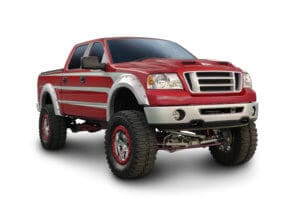Pros and Cons of Lifted Truck Systems
Lifted trucks appeal to many vehicle owners for a variety of reasons. Adding extra inches off the ground can improve the truck’s performance in off-road conditions. For others, a taller truck with more massive tires is more visually appealing. Whatever the reason, there are several ways to accomplish this goal. To help you choose the best option, here’s a short overview of lifted truck systems available on the market.
 Body Lift Kits
Body Lift Kits
Body lift kits are the simplest and least expensive way to add height to a vehicle, but they can only be used for certain types of trucks and SUVs. Vehicles are constructed as either body-on-frame or unibody. As the name suggests, body-on-frame vehicles have a body attached to a steel frame and chassis. The body can be removed for these vehicles, and the lift kit made up of spacers is inserted onto the frame before the body is reattached. Unibody vehicles cannot be separated in this manner, so this method cannot be used.
While this is the easiest method, it has the least amount of impact on the truck. The most significant benefit of a body lift kit is the ability to use bigger tires. In fact, it’s only by using larger tires that a vehicle with a lift kit will achieve noticeable height. For those people who desire a lifted truck look without needing more functionality, a body lift kit will do the job. However, these kits usually raise the center of gravity, making the vehicles more susceptible to rollovers.
Suspension Lift Kits
These kits are more difficult to install and cost more than body lift kits. However, this is the way to go for people who want to have substantial height since they can be used to lift the vehicle a foot or more. In this scenario, the entire suspension is removed and replaced.
Most factory-installed lift systems are this type of setup. One benefit to a factory-installed system is that it is usually included in the purchase price of the truck so it can be included as part of your auto loan. Another is that the vehicle’s warranty will likely include the suspension lift system, too.
This is the way to go for truck and SUV owners who want serious off-roading functionality. Suspension lift kits will improve the vehicle’s performance in challenging, off-road conditions. Often this system will also allow for large, heavy-duty tires. On the other hand, suspension lift kits wear down faster than factory-installed standard systems. They may make it difficult or impossible to tow trailers or motorhomes. Vehicle owners may be surprised by higher insurance premiums, too.
Other Factors to Consider when Evaluating Lifted Truck Systems
Interested buyers should consider a few other factors when deciding what kind of lifted truck to purchase. First, before altering a vehicle, it’s important to understand any regulations in your area that may limit your options. Next, consider how a taller vehicle may make parking more challenging for you, particularly in parking structures. You’ll likely pay more for fuel since lifted trucks with heavier tires weigh more and will decrease the fuel efficiency of your vehicle.
Finally, you’ll need a good set of mud flaps made specifically for lifted trucks. DuraFlap’s kick back-style mudflaps are made to attach to the truck’s body to provide adequate coverage behind the larger, taller tires. These mud flaps have a bent bracket below the fender well, so the mudflap will not rub on the tires.
See why serious truck owners across the country choose DuraFlap. Our USA-made mud flaps are constructed for durability and functionality that our customers can rely on. Whether you need an extra-wide standard set or driving a heavy-duty dually rig, we’ve got the best mud flaps available for your lifted truck.